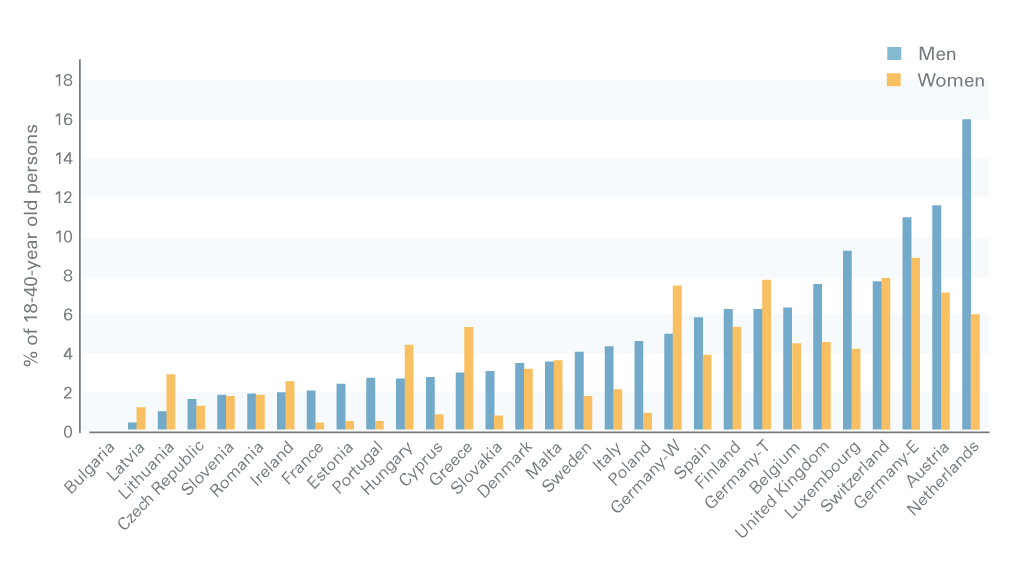Most research so far has related the delay of parenthood to more years spent in education, the difficulties to conciliate work and family life, or to growing economic uncertainty in Europe, often assuming that once the obstacles for childbearing are removed, fertility will rise again. Less attention has been given to childlessness as a conscious decision in explaining fertility patterns. Particularly, quantitative analyses in this area are still scarce.
In the study at hand, Anneli Miettinen and Ivett Szalma focus on childlessness intentions and ideals among young Europeans and report trends based on data from the Eurobarometer survey for the years 2001, 2006 and 2011. In addition, the authors explore whether poorer social and economic resources are associated with voluntary childlessness.
Childlessness can be regarded as both intentional and ideal of women and men. Intentions reflect actual (reproductive) behaviours, considering individual desires and perceived opportunities, as well as obstacles to have a child. Ideals, on the other hand, represent personal attitudes and dispositions towards having a child, and not behaviours per se. Ideals for childlessness are likely to be influenced more by individual and societal norms and values than by the economic or employment situation of individuals. In turn, socio-economic resources may play a bigger role in explaining intention to remain childless. So far, findings have shown that for most young adults in Europe, childlessness is not based on a deliberate intention or desire to remain childless, but on a temporary postponement of parenthood. In addition, there has been no substantial increase in ideal or intentional childlessness over the past decade.
Childlessness as an ideal
Childlessness is relatively rare as a preferred family form in Europe, ranging from below 1% to around 6% in most countries in 2011 (Figure 1). It is seldom considered as an ideal in Eastern European countries and relatively rarely (<=2%) in Ireland, France and Portugal. In contrast, childlessness desires are considerably higher, at around 10%, among men in East Germany, Austria and Luxembourg, and at around 8% among women in East and West Germany and Switzerland. In Europe, it is Dutch men who show the strongest preference to remain childless (16% in 2011). On average, men consider childlessness ideal only a little more often than do women in EU-15 countries (6% and 4% respectively), while there is barely any gender differences in Eastern European countries (at 2% and 1.6%).

Figure 1. Childlessness ideals among 18–40 year old men and women (% of all men/women in the age group 18–40 who considered zero children their ideal family size). Eurobarometer 2011.
Source: Eurobarometer 2011 and Swiss Household Panel (for Switzerland). Authors’ calculations.
Childlessness intentions
Childlessness intentions, i.e. actual corresponding reproductive behaviour, is also rare among young adults in Europe, although it is more common than childlessness as a preferred family form: On average (EU-27), 7% of men and 5.2% of women in the age group 18–40 years intended to remain childless according to Eurobarometer data from 2011. There is, however, considerable variation among societies. For instance, the proportion of men, who intend to remain childless is more than 10% in Austria, Spain and Sweden. In East Germany, Luxembourg, Switzerland and the Netherlands the rates of intentional childlessness among 18–40-year-old men exceed 15%. For women, the highest rates of intended childlessness are observed in Belgium, East Germany, Luxembourg, Switzerland, the Netherlands and the UK, with values varying between 10% and 14%. Intentional childlessness is relatively low in eastern and central Europe, ranging from below 1% to around 5% for both men and women.
In summary, these results suggest that there are at least two demographically distinctive groups in Europe with respect to intentional childlessness (both desired and intended childlessness): Relatively high rates of intentional childlessness characterise Austria, Germany, Switzerland, the Netherlands and Luxembourg, while the lowest rates are found in Eastern European countries, France and Ireland.
Childlessness and socioeconomic conditions
The authors found that having fewer socioeconomic resources influenced childlessness intentions through multiple ways: Lower educational attainment or lower socioeconomic position, being unemployed or in a less secure employment situation were negatively related to childbearing intentions, while their role was not as clear in explaining childlessness ideals. Particularly in the post-socialist countries, where unemployment is a relatively new phenomenon, employment uncertainty may be perceived as more threatening. At a country-level, the negative effect of the socioeconomic situation is less evident: The contextual economic situation does not impede childbearing intentions when it comes to having a first child.

*This PopDigest has received funding from the European Union's Seventh Framework Programme (FP7/2007-2013) under grant agreement n° 320116 for the research project FamiliesAndSocieties.
FamiliesAndSocieties (www.familiesandsocieties.eu) has the aim to investigate the diversity of family forms, relationships and life courses in Europe, to assess the compatibility of existing policies with these changes, and to contribute to evidence-based policy-making. The consortium brings together 25 leading universities and research institutes in 15 European countries and three transnational civil society organizations.